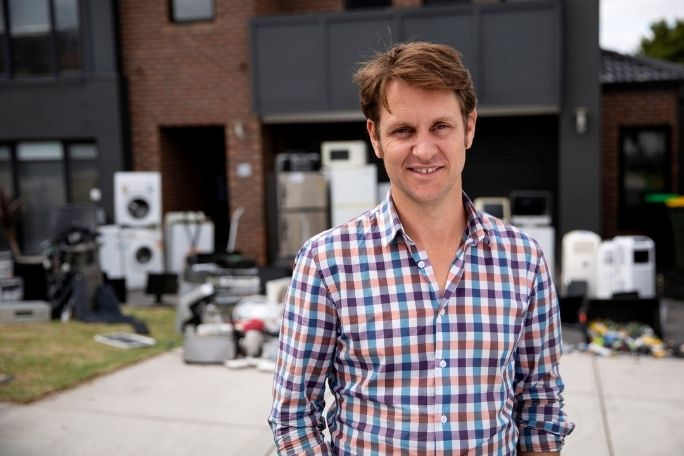Lesson summary
Students explore the topic of e-waste. They begin by looking at the social and environmental impacts of e-waste, before examining two artists who work with e-waste. Students analyse the work of these artists before using the works of these artists to inspire their own e-waste artworks. Students share their ideas with the class and, if time permits, can create and display their completed artworks.
Learning intentions:
Students will...
- understand what e-waste is and where it comes from
- understand some of the environmental impacts of e-waste
- understand how artists communicate artistic intentions and recognise the artistic intentions they will use when creating their own artworks
- recognise the visual conventions used by artists and identify those they personally want to use.
Success criteria:
Students can...
- analyse a range of artworks for their ability to engage audiences around the topic of e-waste
- choose and utilise appropriate art-making techniques in their practice
- draw on existing artworks as inspiration in their art-making practice.
Lesson guides and printables
Lesson details
Curriculum mapping
Australian curriculum content descriptions:
Years 7 and 8 Visual Arts:
- Experiment with visual arts conventions and techniques, including exploration of techniques used by Aboriginal and Torres Strait Islander artists, to represent a theme, concept or idea in their artwork (ACAVAM118)
- Develop ways to enhance their intentions as artists through exploration of how artists use materials, techniques, technologies and processes (ACAVAM119)
- Develop planning skills for art-making by exploring techniques and processes used by different artists (ACAVAM120)
- Practise techniques and processes to enhance representation of ideas in their art-making (ACAVAM121)
- Analyse how artists use visual conventions in artworks (ACAVAR123)
Years 9 and 10 Visual Arts:
- Conceptualise and develop representations of themes, concepts or subject matter to experiment with their developing personal style, reflecting on the styles of artists, including Aboriginal and Torres Strait Islander artists (ACAVAM125)
- Manipulate materials, techniques, technologies and processes to develop and represent their own artistic intentions (ACAVAM126)
- Develop and refine techniques and processes to represent ideas and subject matter (ACAVAM127)
- Plan and design artworks that represent artistic intention (ACAVAM128)
- Evaluate how representations communicate artistic intentions in artworks they make and view to inform their future art making (ACAVAR130)
Syllabus outcomes: VAS4.1, VAS4.3, VAS4.4, VAS4.6, VAS5.1, VAS5.3, VAS5.4, VAS5.5, VAS5.7
General capabilities: Critical and Creative Thinking
Cross-curriculum priority: Sustainability OI.6
Relevant parts of Year 7 and 8 Visual Arts achievement standards: Students identify and analyse how other artists use visual conventions and viewpoints to communicate ideas and apply this knowledge in their art-making. Students plan their art-making in response to exploration of techniques and processes used in their own and others’ artworks. They demonstrate the use of visual conventions, techniques and processes to communicate meaning in their artworks.
Relevant parts of Year 9 and 10 Visual Arts achievement standards: Students evaluate how representations communicate artistic intentions in artworks they make and view. They analyse connections between visual conventions, practices and viewpoints that represent their own and others’ ideas. They identify influences of other artists on their own artworks. Students manipulate materials, techniques and processes to develop and refine techniques and processes to represent ideas and subject matter in their artworks.
This lesson is part of the wider unit of work: War On Waste – Years 7-10.
Time required: 130+ mins
Level of teacher scaffolding: Medium – facilitate discussions, and oversee analysis, planning and creation of artworks
Resources required
- Device capable of presenting an online clip to the class.
- E-waste items (optional)
- Other art-making materials (optional)
- Student Worksheet – one copy per student
Skills
This lesson is designed to build students’ competencies in the following skills:
- Communication
- Community engagement
- Creativity
- Critical thinking
Additional info
Cool Australia’s War On Waste lessons have been developed in partnership with Lune Media and with support from the Australian Environmental Grantmakers Network. These lessons have been designed to lead students through a deeper understanding of some of the big issues relating to waste in Australia and to support them to take action to reduce the impact of waste on our environment.


Welcome back!
Don't have an account yet?
Log in with:
By signing up to Cool.org you consent and agree to Cool's privacy policy to
store, manage and process your personal information. To read more, please see
our privacy policy here(Opens in new tab).
Create your free Cool.org account.
Many of our resources are free, with an option to upgrade to Cool+ for premium content.
Already have an account?
Sign up with:
By signing up to Cool.org you consent and agree to Cool's privacy policy to
store, manage and process your personal information. To read more, please see
our privacy policy here(Opens in new tab).